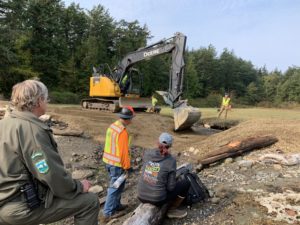
In 2013, Friends partnered with Washington State Parks to plan beach and wetland restoration actions at Sucia Island’s Mud Bay. Located along a major migratory pathway for juvenile Chinook salmon, Sucia’s marine shorelines are a top priority for salmon recovery efforts in San Juan County. Sucia’s Mud Bay hosts a forage fish spawning beach and a salt marsh, providing rare and valuable habitat for juvenile salmon and the marine food web that supports fish, birds, and marine mammals.
Before the project began, a decades old, low-lying road crossed the beach and salt marsh at Mud Bay. The road blocked tidal exchange and fish passage, burying forage fish spawning habitat, and preventing the site from adjusting to rising sea levels.
Restoration actions completed in the Fall of 2020 included full removal of the shoreline road and its associated fill, rock, concrete armoring, and the undersized culvert. The beach was nourished with rounded sand and small gravel. To allow full restoration, a new low impact road was installed at an inland location to provide Parks staff access to their maintenance buildings.
The tide now comes into the marsh unimpeded for the first time in over 75 years. The restored habitat will now directly support migrating juvenile salmon, forage fish, and through the marine food web, our endangered orca.
Project acknowledgements: Washington State Parks, Mike Carlson Enterprises, Rain Shadow Consulting, Coastal Geologic Services, Caldera Archeology, Rozewood Environmental Services, Long Live the Kings and the San Juan Islands Civilian Conservation Corps.
Funding was provided by: Washington Salmon Recovery Funding Board, Estuary and Salmon Restoration Program, Department of Ecology Coastal Protection Fund, the U.S. Fish & Wildlife Service, Washington State Parks and Friends members.

